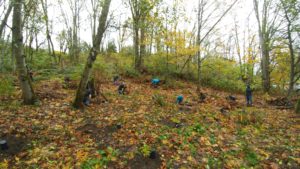Park Profile: Delridge & Myrtle
We began our series of park profiles in mid-2020, as Seattle was working and sheltering at home. Our goal was to educate folks about smaller, uncrowded neighborhood parks that could offer a valuable escape from the indoors. As Seattle begins to return to normalcy, the time feels right to finish off our park profile series.
We’re returning this week with a park profile on perhaps our most unassuming park, the geographically named Delridge and Myrtle. Its one-sentence official bio describes it thusly: “Delridge and Myrtle Park is an undeveloped greenspace at the intersection of Myrtle Street and Delridge Way Southwest.” 
Despite not boasting any official (or unofficial) hiking trails, most of Delridge and Myrtle can be experienced from the periphery – 16th Ave SW passes the park on its east side and Delridge Way SW passes on the west. The south side of the site is marked by one of Seattle’s 600-plus public staircases, this one measuring in at about 170 steps!
As a result of that elevation change from west to east, the site boasts some very steep slopes in places. This is perhaps also the reason the three-acre site was never developed into housing as most of the surrounding land has been. Steep slopes often have environmental protections because they can be damaged by activities such as grading and clearing, causing erosion and sending excessive sediment into water systems.
There are also some species that specifically thrive on slopes. Delridge and Myrtle has a substantial population of Pacific madrone (Arbutus menziesii), a native broadleaf evergreen tree whose colorful, peeling bark makes it iconic in the Pacific Northwest. Since at least the 1990s, experts have been concerned by the region-wide decline of these trees, a problem that has not, to date, been solved. (Check out this thorough blog post from our friends at Green Seattle for more information and details on recovery efforts). This makes the population at Delridge and Myrtle all the more special, and part of the incentive for our conservation work there.
Beginning in 2017, DNDA has conducted invasive species removal, established native trees and shrubs, and applied mulch throughout the less-steep areas of the site. The objective of our work is to improve the overall forest conditions and to enhance the valuable ecosystem functions the site provides, even in the absence of hikers.
At present, the biggest nuisances to the site are the presence of invasive plant species. The list is long and includes usual suspects such as Himalayan blackberry and reed canary grass, as well as bindweed and creeping buttercup.
If any of this has inspired you, come join us. We host volunteer events every Tuesday and Thursday and on alternating Saturdays – one of which is sure to be at Delridge and Myrtle!



